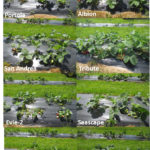With the support of the Purdue Extension AgSeed Program, we are currently evaluating different production systems for growing strawberries in an open-field with plastic cultural systems for our area at Southwest Purdue Agricultural Center in Vincennes, IN.
A day-neutral strawberry cultivar evaluation trial was established in the Spring of 2019. The evaluated cultivars include Portola, Evie-2, Mara Des Bois, Albion, Seascape, San Andreas, Monterey, and Tribute. Bare-root plants purchased from Nourse Farm and Indiana Berry were planted on black plastic mulch on Mar. 22. Cultivar Portola was planted on Apr. 10 due to back-order. Each of the eight cultivars were grown either with a retractable low tunnel system or without it (Figure 1).
Although strawberries were planted this spring, most cultivars started to bloom toward the end of April. Removing runners started in early May. During the week of May 13, harvest started on the early cultivars: Tribute, Mara Des Bois, then followed by Evie-2 and Albion. The majority of the harvested berries have high quality. Plants grown under retractable low tunnels in general developed more foliage, and started harvest about a week earlier than plants grown without the low tunnel (Figures 2 and 3).
- Figure 2: Eight day-neutral strawberry cultivars grown under retractable low tunnel systems (picture was taken on May 20)
- Figure 3: Eight day-neutral strawberry cultivars grown in the open-field (picture was taken on May 20)
What we have learned so far is that for the extended harvest of day-neutral strawberries, planting them as early as possible could lead to a decent spring harvest depending on the cultivar. Newly planted strawberry plants can with stand below frost temperatures. Actually, as they were planted in March, there were a few nights temperatures were below 30°F, with the lowest recorded temperature at 26°F. No cold damage was observed on these plants. The only cultivar that was poorly established was Portola, and this was likely due to uneven irrigation when they were planted in April.
The retractable low tunnels enhanced strawberry growth and advanced the harvest time with accumulated heat. It worked well in the spring. Starting this week, we plan to open the low tunnels and close them when it rains. The idea now is to keep the plant canopy and berries as dry as possible in order to reduce disease pressure.
Looking forward, we estimate the spring harvest will end when temperatures exceed 85 to 90°F, as the high temperatures inhibit further flower bud formation and reduce fruit quality. The harvest should continue in the fall.
Locally grown strawberries are a popular produce in the local food market. Although growing day-neutral strawberries in the open-field condition may not be a profitable business for larger vegetable and fruit growers due to the extended but relatively small harvests. Growing day-neutral strawberries could be a potential opportunity for small and diversified farmers.
Please stay tuned for our update of this trial, as well as evaluations of more strawberry production systems in southern Indiana.


